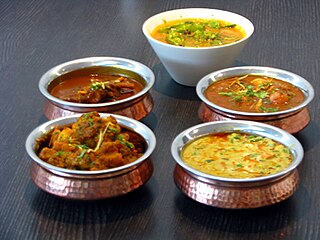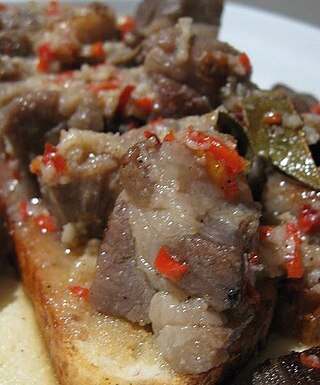
Curry is a dish with a sauce seasoned with spices, mainly associated with South Asian cuisine. It is not to be confused with leaves from the curry tree, though some curries do include curry leaves. Curry is also found in the native cuisines of many South East Asian and East Asian countries due to ancient contact with South Asia.

Tripe is a type of edible lining from the stomachs of various farm animals. Most tripe is from cattle, pigs and sheep.

Fried rice is a dish of cooked rice that has been stir-fried in a wok or a frying pan and is usually mixed with other ingredients such as eggs, vegetables, seafood, or meat. It is often eaten by itself or as an accompaniment to another dish. Fried rice is a popular component of East Asian, Southeast Asian and certain South Asian cuisines, as well as a staple national dish of Indonesia. As a homemade dish, fried rice is typically made with ingredients left over from other dishes, leading to countless variations. Fried rice first developed during the Sui Dynasty in China.

Trinidad and Tobago has a unique history and its food is influenced by Indian-South Asian, West African, Creole, European, American, Chinese, Amerindian, and Latin American culinary styles. Trinidadian and Tobagonian food is dominated by a wide selection of dishes, most notably, doubles, roti, pelau, callaloo and curried crab and dumplings. Trinidad and Tobago is also known for its prepared provisions, such as dasheen, sweet potato, eddoes, cassava, yam, soups and stews, also known as blue food across the country. Corresponding to the Blue Food Day event held annually in Trinidad and Tobago.

Adobo or adobar is the immersion of food in a stock composed variously of paprika, oregano, salt, garlic, and vinegar to preserve and enhance its flavor. The Portuguese variant is known as carne de vinha d'alhos. The practice, native to Iberia, was widely adopted in Latin America, as well as Spanish and Portuguese colonies in Africa and Asia.

South African cuisine reflects the diverse range of culinary traditions embodied by the various communities that inhabit the country. Among the indigenous peoples of South Africa, the Khoisan foraged over 300 species of edible food plants, such as the rooibos shrub legume, whose culinary value continues to exert a salient influence on South African cuisine. Subsequent encounters with Bantu pastoralists facilitated the emergence of cultivated crops and domestic cattle, which supplemented traditional Khoisan techniques of meat preservation. In addition, Bantu-speaking communities forged an extensive repertoire of culinary ingredients and dishes, many of which are still consumed today in traditional settlements and urban entrepôts alike.

Noodle soup refers to a variety of soups with noodles and other ingredients served in a light broth. Noodle soup is a common dish across East Asia, Southeast Asia and the Himalayan states of South Asia. Various types of noodles are used, such as rice noodles, wheat noodles and egg noodles.

Kerala cuisine is a culinary style originated in the Kerala, a state on the southwestern Malabar Coast of India. Kerala cuisine offers a multitude of both vegetarian and non-vegetarian dishes prepared using fish, poultry and red meat with rice as a typical accompaniment. Chillies, curry leaves, coconut, mustard seeds, turmeric, tamarind, asafoetida and other spices are also used in the preparation.

Sindhi cuisine refers to the distinct native cuisine of the Sindhi people from Sindh, Pakistan. Sindhi cuisine has been influenced by Central Asian, Iranian, Mughal food traditions. It is mostly a non-vegetarian cuisine, with even Sindhi Hindus widely accepting of meat consumption. The daily food in most Sindhi households consists of wheat-based flat-bread (Mani) or rice accompanied by two dishes, one gravy and one dry with curd, papad or pickle. Freshwater fish and a wide variety of vegetables are usually used in Sindhi cuisine. Restaurants specializing in Sindhi cuisine are rare, although it is found at truck stops in rural areas of Sindh province, and in a few restaurants in urban Sindh.
Goan cuisine consists of regional foods popular in Goa, an Indian state located along India's west coast on the shore of the Arabian Sea. Rice, seafood, coconut, vegetables, meat, bread, pork and local spices are some of the main ingredients in Goan cuisine. Use of kokum and vinegar is another distinct feature. Goan food is considered incomplete without fish.

Indian Singaporean cuisine refers to food and beverages produced and consumed in Singapore that are derived, wholly or in part, from South Asian culinary traditions. The great variety of Singapore food includes Indian food, which tends to be Tamil cuisine and especially local Tamil Muslim cuisine, although North Indian food has become more visible recently. Indian dishes have become modified to different degrees, after years of contact with other Singapore cultures, and in response to locally available ingredients as well as changing local tastes. The local forms of Indian food may be seen as localised or even regional variations of Indian food, or in some cases, a form of hybrid Indian-Singaporean cuisine. Popular 'Indian' dishes and elements of Indian cuisine include:

Carne de vinha d'alhos is a Portuguese dish prepared using a marinade of salt, paprika, chili paste, wine or vinegar, and garlic. Originating in Minho, it is traditionally served at Christmas time in Madeira.

Philippine adobo is a popular Filipino dish and cooking process in Philippine cuisine. In its base form, meat, seafood, or vegetables are first browned in oil, and then marinated and simmered in vinegar, salt and/or soy sauce, and garlic. It has occasionally been considered the unofficial national dish in the Philippines.

Angolan cuisine has many dishes popular among nationals and foreigners, including funge, mufete, calulu, moamba de galinha, moamba de ginguba, kissaca, and mukua sorbet.
Barbadian cuisine, also called Bajan cuisine, is a mixture of African, Portuguese, Indian, Irish, Creole, Indigenous and British background. A typical meal consists of a main dish of meat or fish, normally marinated with a mixture of herbs and spices, hot side dishes, and one or more salads. The meal is usually served with one or more sauces.

A stew is a combination of solid food ingredients that have been cooked in liquid and served in the resultant gravy. Ingredients can include any combination of vegetables and may include meat, especially tougher meats suitable for slow-cooking, such as beef, pork, venison, rabbit, lamb, poultry, sausages, and seafood. While water can be used as the stew-cooking liquid, stock is also common. A small amount of red wine or other alcohol is sometimes added for flavour. Seasonings and flavourings may also be added. Stews are typically cooked at a relatively low temperature, allowing flavours to mingle.




















